#Aethia cristatella
Text

A crested auklet (Aethia cristatella) sits cliffside on St Paul Island, Alaska, USA
by Isaac Sanchez
#crested auklet#auks#seabirds#birds#aethia cristatella#aethia#alcidae#Charadriiformes#aves#chordata#wildlife: alaska#wildlife: usa#wildlife: north america
386 notes
·
View notes
Photo

Crested Auklet
754 notes
·
View notes
Photo

Crested Auklet for a $5 Ko-fi supporter
#art#my art#digital#digital art#clip studio#clip studio paint#csp#kofi#ko-fi#kofi commissions#commissioned work#request#doodle#lineless#stylized#angular#polygonal selection tool#crested auklet#Aethia cristatella#birdblr#lazert#lazer-t
93 notes
·
View notes
Text
BOTD: Crested Auklet

^Image credit: F. Deines
Crested Auklet (Aethia cristatella)
Crested Auklets have a range of remarkable traits used for mating. These include their crests, loud 'trumpet' calls, and a distinct scent like that of citrus fruit. Crested Auklets with larger crests are more likely to obtain mates.
#crested auklet#aethia cristatella#auklet#bird of the day#bird facts#birding#bird#weird and wonderful#birds of the pacific ocean#ornithology#birds#bird fact#bird behaviour#bird breeding#birdoftheday#bird-of-the-day
150 notes
·
View notes
Note
🥚 (I've seen so many new birds thanks to this ask game and I love it 💜)
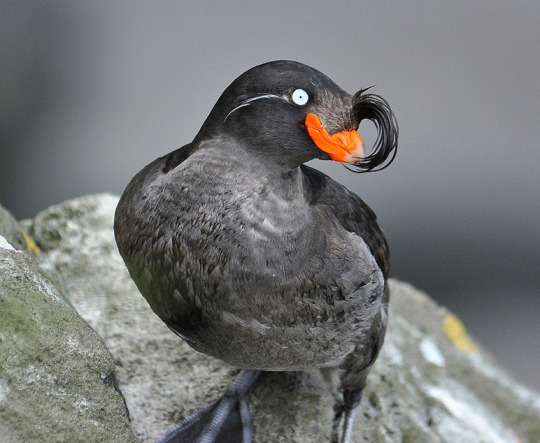
Well here's another one
crested auklet!
(Aethia cristatella)
40 notes
·
View notes
Photo

Rowdy & raunchy: For eight weeks each spring, crested auklet (Aethia cristatella) crowd shorelines and vie for mates. Males flash feathers, contract their pupils (pictured above), yap like small dogs, and—if they find a potential mate—release a tangerine-scented substance that may act like an aphrodisiac.
PHOTOGRAPH BY MARIE READ, NATURE PICTURE LIBRARY
#marie read#photographer#nature picture library#national geographic#crested auklet#aethia cristatella#bird photography#nature
36 notes
·
View notes
Text

Crested Auklet (Aethia cristatella), family Alcidae, Kiska Island, Alaska
photograph via: U.S. Fish & Wildlife Service
424 notes
·
View notes
Text

[2743/11080] Crested auklet - Aethia cristatella
Order: Charadriiformes
Suborder: Lari
Family: Alcidae (auks)
Photo credit: Phillip Edwards via Macaulay Library
247 notes
·
View notes
Photo
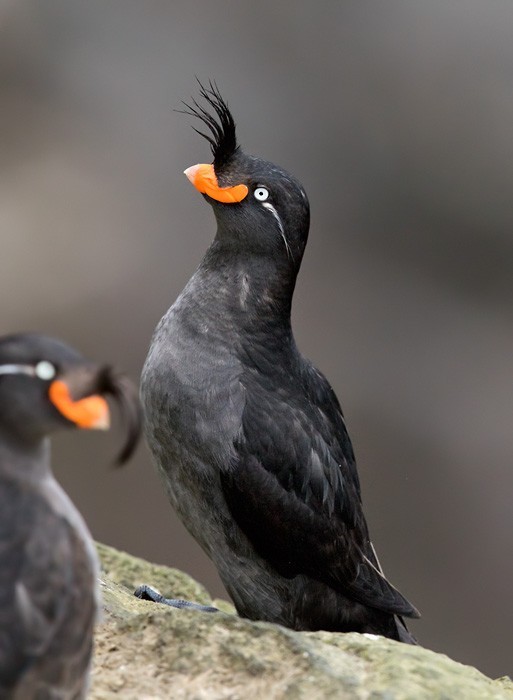
Crested Auklet (Aethia cristatella)
© Lars Petersson
223 notes
·
View notes
Photo
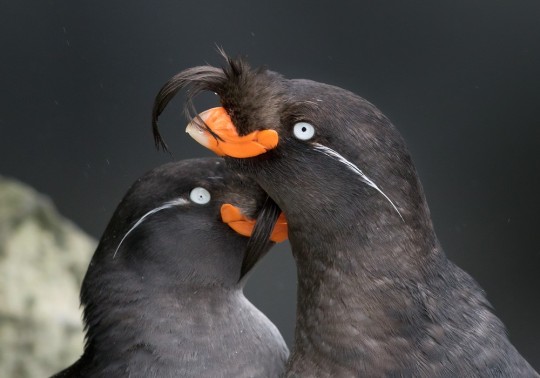
Crested Auklet (Aethia cristatella)
© Lars Petersson
241 notes
·
View notes
Photo

Crested Auklet (Aethia cristatella)
© Lars Petersson
62 notes
·
View notes
Photo

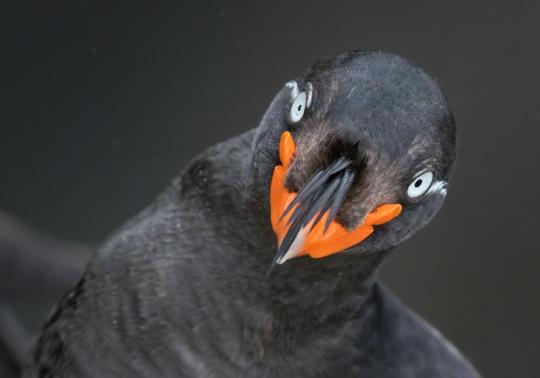



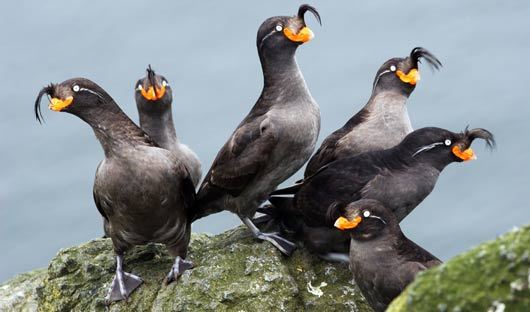



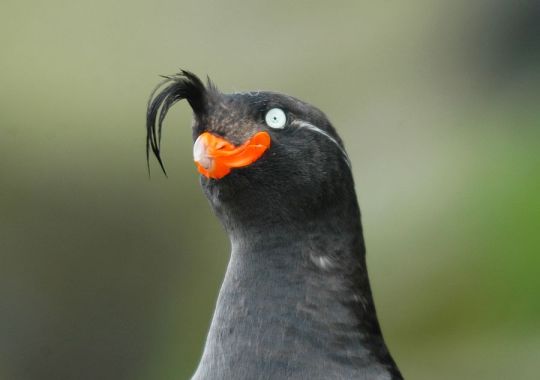
The crested auklet (Aethia cristatella) is a small seabird of the family Alcidae, distributed throughout the northern Pacific and the Bering Sea. The species feeds by diving in deep waters, eating krill and a variety of small marine animals. It nests in dense colonies of up to 1 million individuals in the Bering Sea and the Sea of Okhotsk. The species is known for its sexual ornaments, found in both males and females. These include colorful plumage with a forehead crest, a striking scent recalling citrus fruit, and a loud trumpet call, all of which appear to have evolved through sexual selection.
The crested auklet can measure 7.1–10.6 inches in length, 13–20 inches in wingspan and weigh 195–330 g.They have a reddish-orange and yellow tipped bill, yellowish white irises, and white auricular plumes from their eyes to their ears. Their bodies, wings, and tails are primarily dark sooty grey, while their legs and feet are grey and claws black. The males and females are very similar, although the females have slightly smaller and less curved bills, additionally slightly smaller crests. In winter plumage, their bills are smaller and dull yellow. They lack accessory plates and their crest and auricular plumes are reduced.
Crested auklets are known for their forehead crests, which is made of black forward-curving feathers. These forehead crests are highly variable, and can have between two and twenty three narrow forward curving feathers. The average auklet has 12 crest feathers, which are of variable length, between 8.1 and 58.5 millimetres. Auklets have auricular plumes and a bright orange bill with curved accessory plates. Like forehead crests, these features vary widely within auklet populations.
Crested auklets produce a social odor during the breeding season, described as smelling like tangerines. This odor originates from tiny wick feathers, located in a small patch of skin between the shoulder blades.The scent is released when there is ruffling of feathers on the nape and upper back of the individual from threat, trumpeting, or billing displays. The cloud of scent released encourages the ruff sniff display, when birds fully insert their half open bill into the other's plumage. This display occurs in the absence of obvious aggression and is important for pair formation. For both sexes, a strong odor attracts more individuals.Odor secretions increase during the breeding season, highlighting its association with courtship and mate selection. The scent may also act as an ectoparasite repellent.
Crested auklets are highly social during the breeding season, before pair formation, and after pair formation. Within a breeding year, however, crested auklets are monogamous, with only 10% of the population having extra-pair copulations. Partners continue to self-advertise to other birds when they are not incubating. While some of this advertising behavior can be linked to extra-pair mating, it is suggested that continuation of the behavior allows birds to find pairs for the next breeding season. Only 45.5% of birds remain with the same partner in the subsequent breeding season.
Crested auklets are found throughout the northern Pacific Ocean and Bering Sea. They are particularly prevalent during the non-breeding winter months along the Aleutian Islands, Kuril Islands and the Russian island of Sakhalin. They travel to breeding locations on the islands and shorelines of the Sea of Okhotsk and the Bering Sea during the late spring and summer. Their habitats consist of slopes, boulder fields, lava flows, and sea cliffs.
According to the IUCN, crested auklets are a species of least concern. The global population exceeds 8.2 million individuals, while the North American population is estimated at 2.9 million birds. However, an accurate assessment of the number of birds is difficult, since those on the surface of the colony and in the nearby sea form only a small proportion of the variable and poorly understood population. There is greater concern for the Alaskan population. There has been high predation by rats which have escaped from fishing vessels in the harbor. Oil spills and collisions with light sources (such as fishing boats) pose additional risks.
#crested auklet#aethia cristatella#auks#auklets#black birds#sea birds#squawktober#just look at thes glorious idiots#absolute dorks#i love them
4K notes
·
View notes
Text
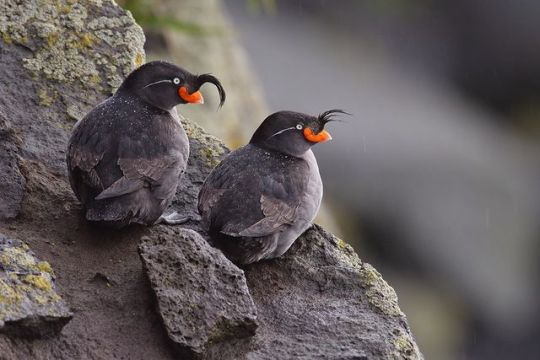
Crested Auklet
28 notes
·
View notes
Photo
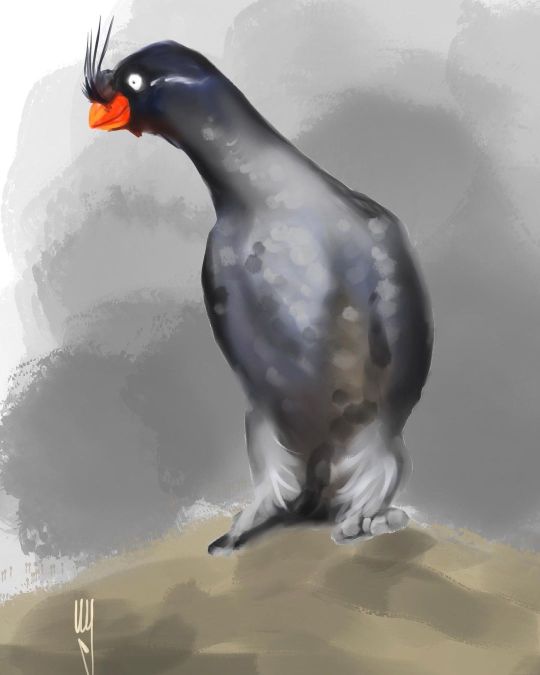
The crested auklet (Aethia cristatella) is a small seabird of the family Alcidae, distributed throughout the northern Pacific and the Bering Sea. #birds #auklet #auks #birdwatching #birdart #birdpainting #animalart #ulf #artmagenta #procreateart https://www.instagram.com/p/COafxOfghIe/?igshid=wii4xjij8bxz
0 notes
Photo

Crested Auklet (Aethia cristatella) - photo by Ryan P. O’Donnell
95 notes
·
View notes
